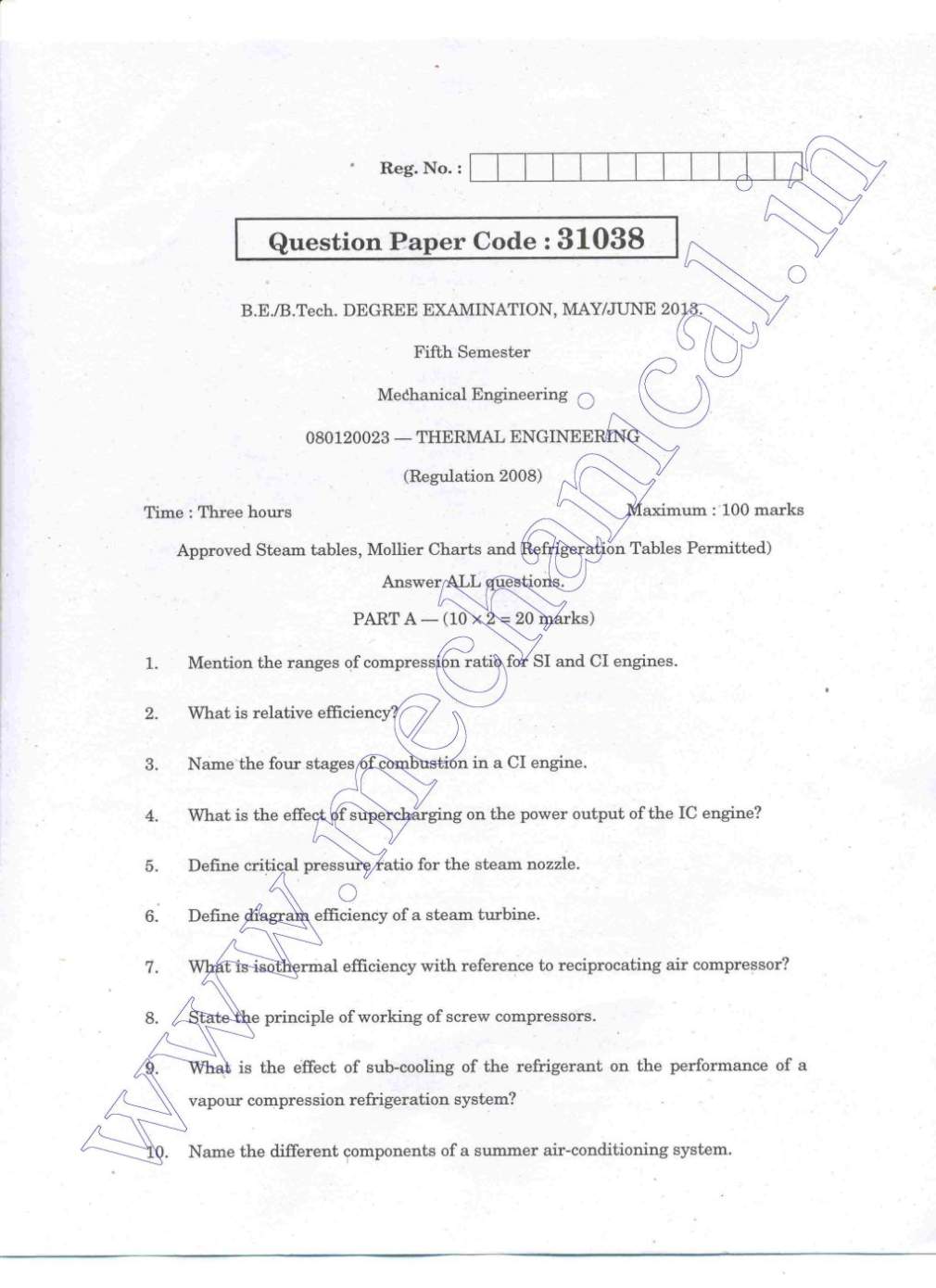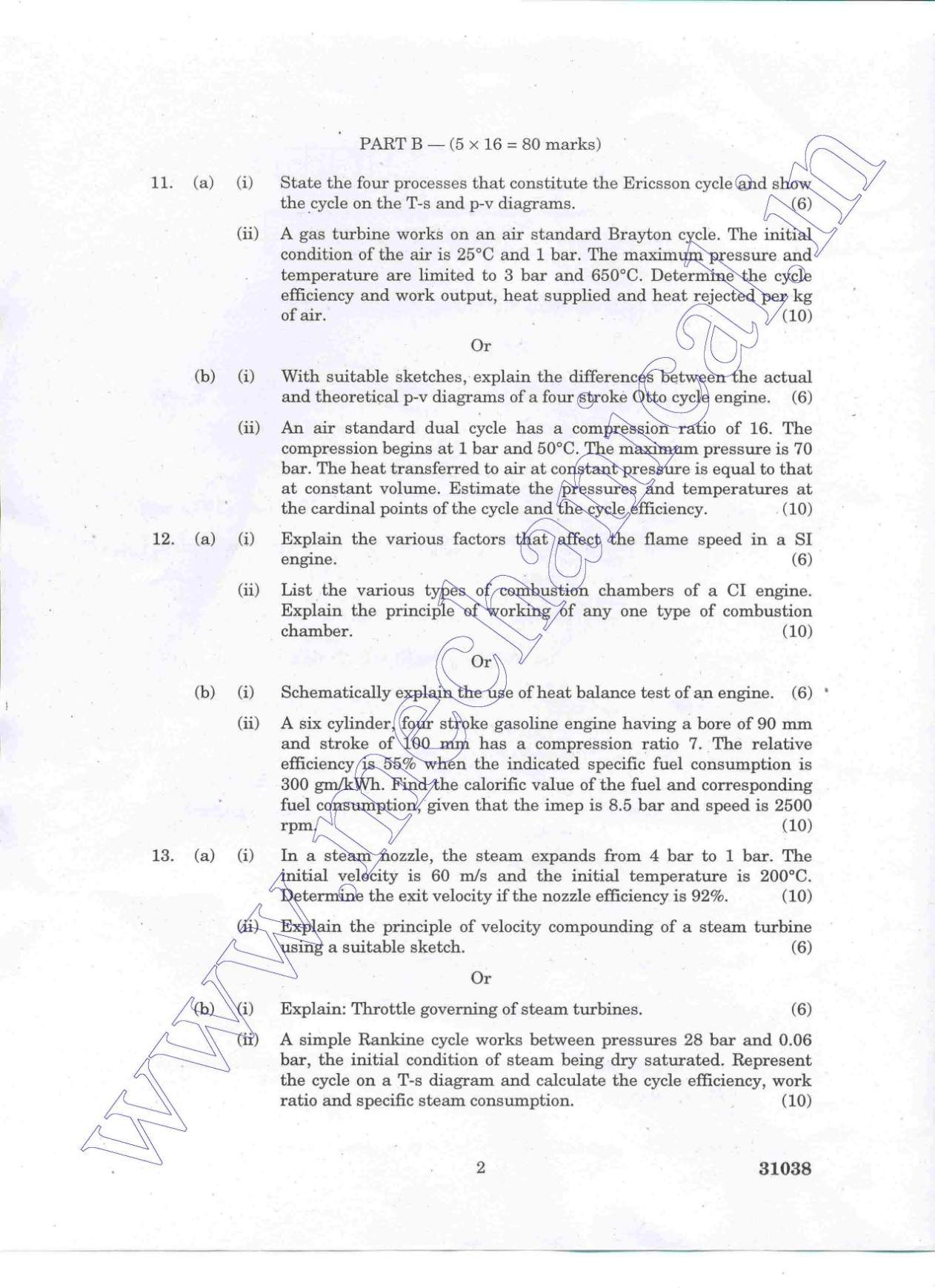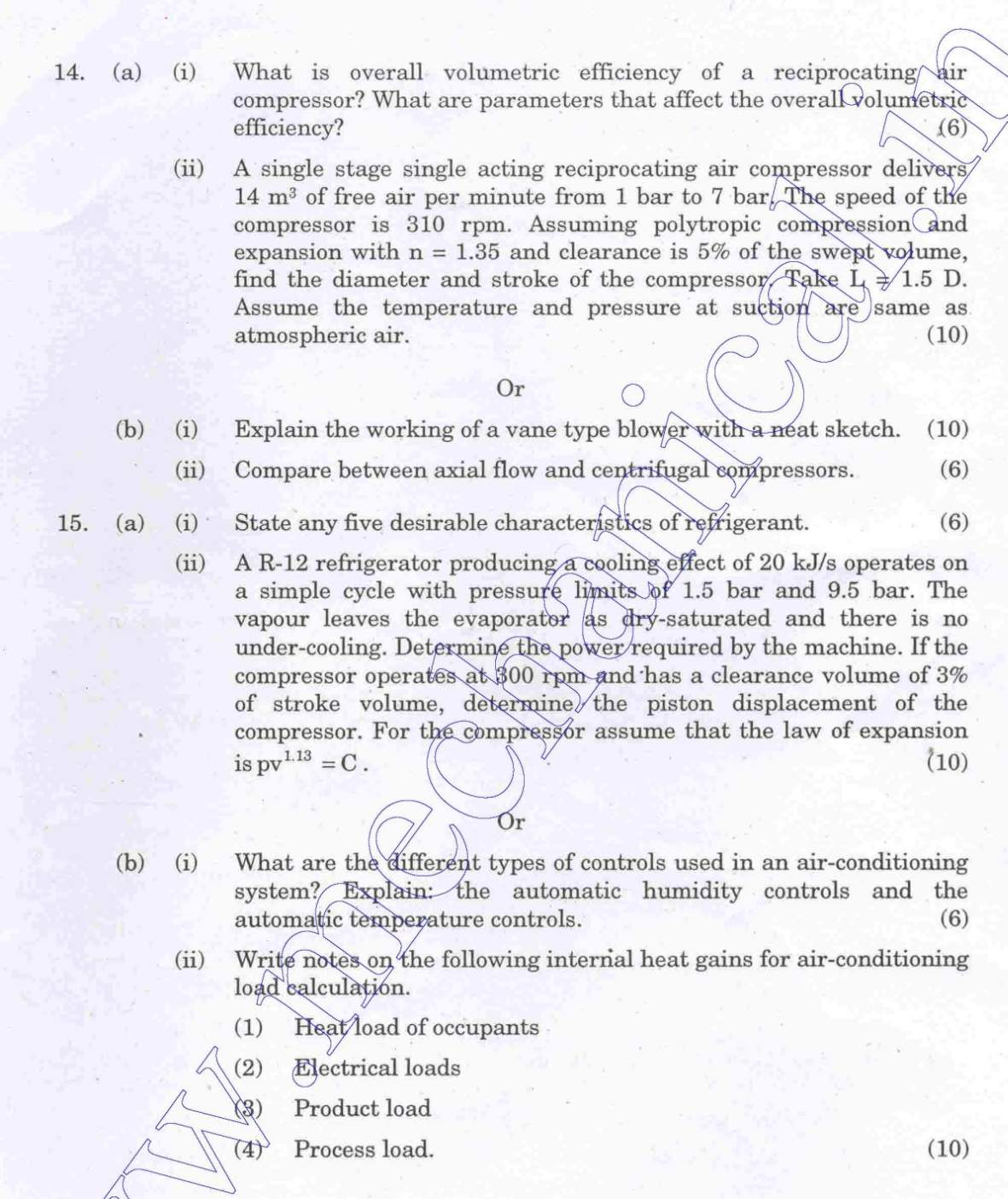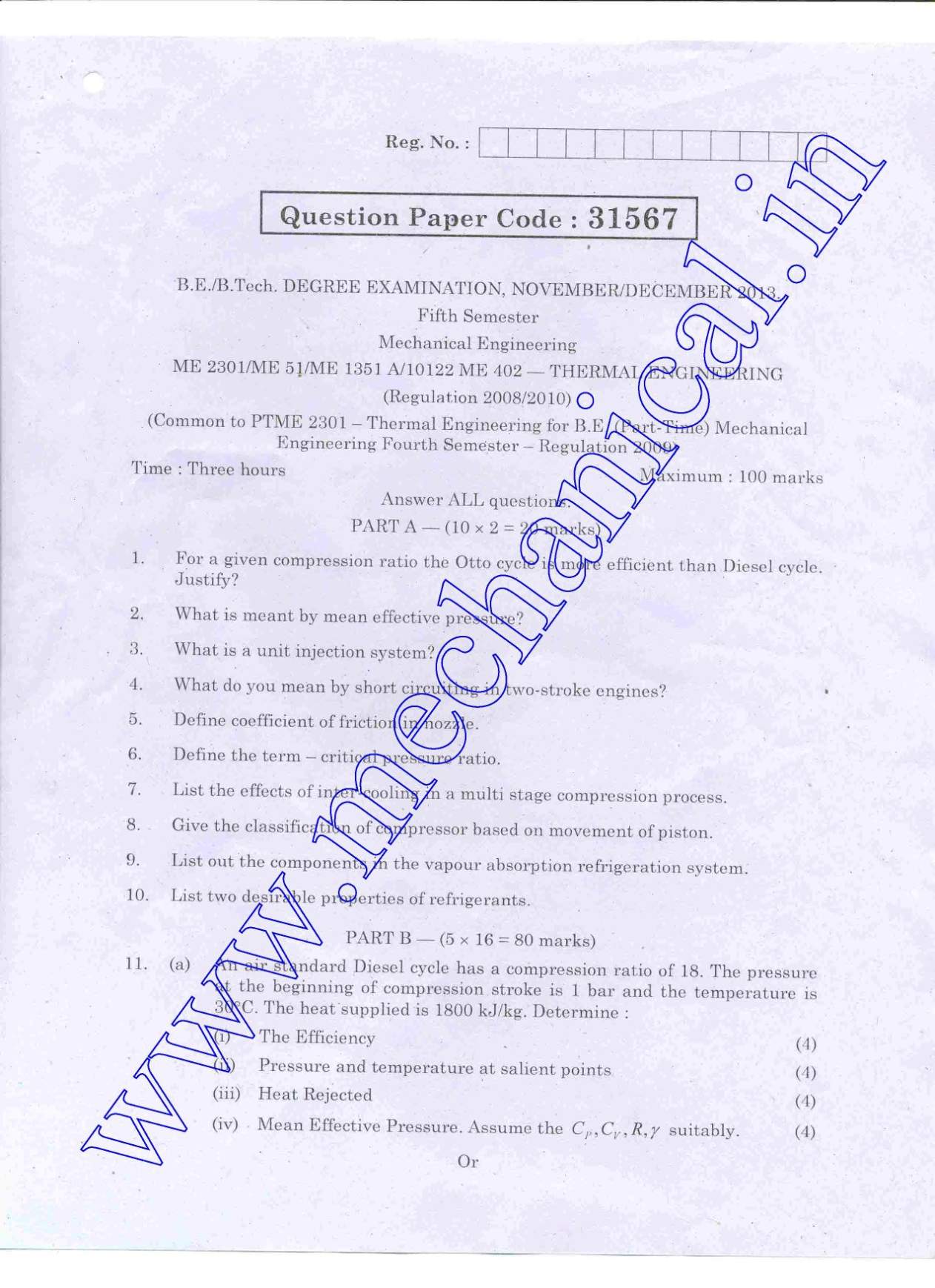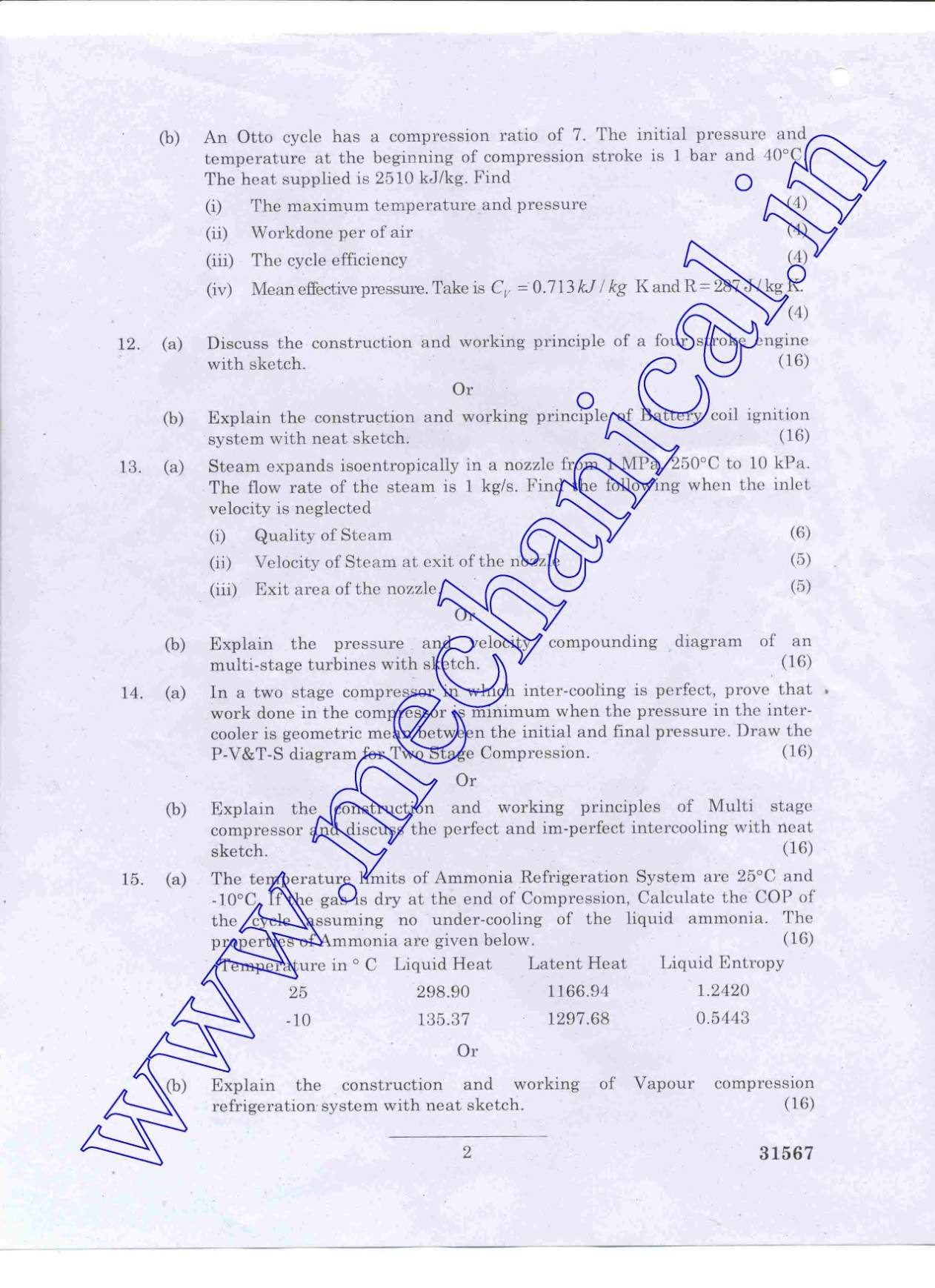Anna University offered Mechanical Engineering and THERMAL ENGINEERING is paper of this course , as you are looking for its paper so on your wish I am giving you same:
THERMAL ENGINEERING
Part-A-Important questions
UNIT-I
• 1.What is meant by cut-off ratio?
• Draw the P-V and T-S diagram for otto cycle.
• What are the assumptions made for air standard cycle analysis?
• 2. Define mean effective pressure as applied to gas power cycles.
• What is the effect of compression ratio on efficiency of otto cycle?
• 2. Draw the actual and theoretical P-V diagram for four stroke cycle SI engine.
• Mention the various processes of dual cycle.
• For the same compression ratio and heat supplied, state the order of decreasing air standard efficiency of Otto, diesel and dual cycle.
• What are the effects of reheat cycle?
• What is thermodynamic cycle?
UNIT-II
• State the merits of a Diesel engine over a petrol engine.
• What is the purpose of thermostat in an engine cooling system?
• What are the effects of introducing regeneration in the basic gas turbine cycle?
• State the purpose of providing piston in IC engines.
• How IC engines are classified based on valve location?
• What is carburetion?
• What do you mean by scavenging in IC engines?
• Differentiate between brake power and indicated power of an IC engine.
• Differentiate between SFC and TFC in engine performance.
• What catalytic converter does?
UNIT-III
• What is supersaturated flow in a nozzle?
• Define nozzle efficiency.
• Why a choke is used in carburetor?
• What is metastsble flow?
• Define stoichiometric air-fuel ratio.
• What is the effect of friction on the dryness fraction of steam leaving a nozzle?
• What are the effects of friction on the flow through a steam nozzle?
• Explain the need of compounding in steam turbines.
• What is meant by governing in turbines?
• What are the different losses involved in steam turbines?
UNIT-IV
• Draw the P-V diagram of a two stage reciprocating air compressor.
• What is ton of refrigeration?
• What is compounding of steam turbine?
• Name the methods of steam turbine governing.
• Why is compounding necessary in steam turbine?
• What is the purpose of using intercooler in multi-stage compression?
• Indicate the application of reciprocating compressors in industry.
• What are the advantages of multi stage compression with inter cooling over single stage compression for the same pressure ratio.
• Why clearance is necessary and what is its effect on the performance of reciprocating compressor?
• Give two merits of rotary compressor over reciprocating compressor.
UNIT-V
• What is the function of analyzer and rectifier in an absorption system?
• Define by-pass factor.
• Give examples for positive displacement compressor.
• What is meant by subcooling in vapour compression system?
• What is the advantage of multi stage air compressor?
• Define dew point temperature
• Define tons of refrigeration and COP.
• What is the difference between air conditioning and refrigeration?
• What are the effect of superheat and subcooling on the vapor compression cycle?
• What are the properties of good refrigerant?
• Define RSHF,RTH.
PART-B Important questions
UNIT-I
1 .The following data relate to the theoretical diesel cycle during air as the working fluid.
Pressure at the end of suction stroke = 1 bar
Temperature at the end of suction stroke = 30ºC
Temperature at the end of constant pressure
Heat addition = 1500ºC
Compression ratio = 16
Specific heat at constant pressure = 1.005 kJ/kg K Specific heat at constant volume = 0.718 kJ/kg K
Find (i) the percentage of stroke at which cut-off takes place
(ii) temperature at the end of expansion.
(iii) the ideal thermal efficiency
2. (i) Sketch the p-v and T-s diagrams for the diesel cycle and obtain an expression for its efficiency.
(ii) If an engine working on Otto cycle and using ideal air as the working substance has its compression ratio raised from 5 to 6, find the percentage increase in efficiency.
3. (i) Derive an expression for the thermal efficiency of an ideal diesel cycle.
(ii) During an otto cycle the pressure at the beginning and end of the compression stroke are 1 bar and 6.75 bar respectively. Find the air standard efficiency of the cycle.
4.(i) Show the dual cycle on P-V and T-S diagrams and derive an expression for its efficiency.
(ii) An engine working on otto cycle has cylinder diameter and stroke are 110mm and 140mm respectively. The clearance volume is 0.25 litres. Find the air standard efficiency of the cycle.
5.The following data relate to the theoretical diesel cycle during air as the working fluid.
Pressure at the end of suction stroke = 1 bar
Temperature at the end of suction stroke = 30ºC
Temperature at the end of constant pressure
Heat addition = 1500ºC
Compression ratio = 16
Specific heat at constant pressure = 1.005 kJ/kg K Specific heat at constant volume = 0.718 kJ/kg K
Find (i) the percentage of stroke at which cut-off takes place
(ii) temperature at the end of expansion.
(iii) the ideal thermal efficiency
6.(i) Sketch the p-v and T-s diagrams for the diesel cycle and obtain an expression for its mean effective pressure.
(ii) An engine working on otto cycle has cylinder diameter and stroke are 110mm and 140mm respectively. The clearance volume is 0.25 litres. Find the air standard efficiency of the cycle.
7.In an air standard Otto cycle the pressure and temp at the beginning of th ecycle is 42 °C and 0.1 Mpa .The compression ratio and maximum temp. of thecycle are 8 and 1250 ° C resp.Find the temp. and pressure at the cardinal points of the cycle.Th eheat supplie dper kg of air. And work done per kg of air,cycle efficicyen and the mep of the engine.
8.In an Air standard brayton cycle ,the air enters the comp at 1 bar an d16 ° .The pressure leaving the colp is 5 bar and the max temp in the cycle is 900 °C .Find the following
(i)comp an the expander work per kg of air
(ii)cycle efficiency
(iii)if an ideal regenerator is incorporated into the cycle determine the percentage change in the efficiency.
9.In an air standard diesel cycle the pressure and temp of the air at the beginning of cycle are 1 bar and 40 °C .The temp before and after the heat supply are 400 °C and 1500°C .Find the air standard eff. And m,ean effective
pr. Of the cycle.what is the poeer output if it makes 100 cycles/min.
10.The pressure ,temp,and volume of air ate the beginning of dual cycle ar e1.03 bar 35 ° C and 150 lts. Resp.Tegh volume after colp is 10 lts. ,42 KJ of heat is added to const. Volume and 63 KJ at const pressure .Determine the air standard eff.Clearance and cutoff percentages.
UNIT-II
1. (i) Compare two stroke and four stroke engine
(ii) Mention the various methods of lubrication system and explain any two in detail.
2. Explain why cooling is necessary in IC engine? With neat sketches describe the working of water cooling system used for a multi cylinder engine. Why should a pump and thermostat be provided in the cooling system of an engine?
3. (i) Compare petrol and diesel engine.
(ii) Explain the construction and working of fuel injector.
4.(i) Explain the working of mechanical fuel pump with a neat sketch.
(ii) Explain the working of magneto ignition system and compare its merits and demerits with battery ignition system.
5. (i) Explain the working of 4-stroke petrol engine.
(ii) what are advantages of lubrication?
6. (i) Sketch the typical valve timing diagram of a high speed 4-stroke petrol engine.
(ii) Explain any one lubrication system adopted in multi cylinder SI engines
7. Explain the different types of cooling systems with neat sketches.
8.What are the common defects that are found in cooling system and give their rectification.?
9.Explain the components of fuel injection system for diesel engines.
10.What are methods of fuel injection available for diesel engines. Explain them in detail with neat sketches.
UNIT-III
1. Dry saturated steam at a pressure of 8 bar enters a convergent divergent nozzle and leaves it at a pressure of 1.5 bar. If the steam flow process is isentropic and if the corresponding expansion index is 1.135, find the ratio of cross sectional area at exit and throat for maximum discharge.
2. (i) Explain with the sketches the velocity and pressure compounded impulse turbines.
(ii) Dry saturated steam enters a steam nozzle at a pressure of 10 bar and is discharged to a pressure of 1.5 bar. If the dryness fraction of a discharged steam is 0.95 what will be the final velocity of steam? Neglect initial velocity of steam
3. . (i) Derive the expression for critical pressure ratio in a steam nozzle.
(ii) In a steam nozzle, the steam expands from 4bar to 1 bar. The initial velocity is 60m/sec and the initial temperature is 200°C. Determine the exit velocity if the nozzle efficiency is 92%.
4. The steam supply to an impulse turbine with a single row of moving blades is 3 kg/sec. The turbine develops 150kW, the blade velocity being 150 m/sec. The steam flows from from a nozzle with a velocity of 450 m/sec and the co efficient of velocity of blade is 0.95. Find the nozzle angle, blade angle at entry and exit, if the steam flows axially after passing over the blades.
5. What is governing? Explain throttle governing and nozzle control governing with neat sketch.
6. A one stage of steam turbine the nozzle expands 9kg/s from a pressure of 1.5 Mpa; 250°C to 600 Kpa. The actual heat drop in the nozzle is 175 KJ/Kg. Calculate the number of nozzles required to give an outlet area for each nozzle approximately 3.5 cm2 and adjust the outlet dimensions to suit this number.
7.Dry saturated steam of 10 bars is expanded in a nozzle to a pressure of 0.7 bars. With the help of mollier diagram ,find the velocity and dryness fraction of steam issuing from the nozzle if friction is neglected.
8.Steam enters a nozzle passing a mass flow rate of 14 kg/s at a pressure of 30 bar and 300 ° C. After expansion to an exit pressure of 6 bars, the exit velocity was 800 m/s. (a) Determine the nozzle efficiency and the exit area. (b) If the loss occurs only in the divergent portion, determine the velocity of steam of the throat.
9.Dry saturated steam at a pressure of 15 bars enters in a nozzle and is discharged at a pressure of 1.5 bar. Find the final velocity of the steam if friction is negligible .If 10% of heat drops due to friction; find the percentage reduction in the final velocity.
UNIT-IV
1. (i) With the help of neat sketch explain the principles of operation of a centrifugal compressor.
(ii) A single acting air compressor compresses air from 1.2 bar to 8 bar. The clearance volume is 2.5 litres. The compression and expansion follows the law PV1.35 = C. If the volumetric efficiency of compressor is 80 %, find the stroke volume and the cylinder dimensions. Assume diameter of the piston is equal to stroke.
2.(i) With the help of schematic and P-V diagram explain the working of a vane type compressor.
(ii) A single stage double acting compressor has a free air delivery of 14 m3/min measured at 1.013 bar and 15ºC. The pressure and temperature in the cylinder during induction are 0.95 bar and 32ºC respectively. The delivery pressure is 7 bar and index of compression and expansion n=1.3. The clearance volume is 5 % of the swept volume. Calculate the indicated power required and the volumetric efficiency
3. With the help of neat sketch explain the principles of operation of a axial flow compressor.
(ii) A single stage double acting air compressor of 62.5 kW I.P. running at 120 rpm takes air at 1 bar and delivers at 10 bar. Assuming the law of expansion and compression as PV1.3=C. Find the diameter and stroke of the cylinder. Take piston speed=200m/min, Volumetric efficiency= 90%. Also find the clearance volume as percentage of stroke volume.
4.(i) Derive an expression for work done in single stage compressor with clearance volume.
(ii) A single stage reciprocating air compressor takes 1m3 of air/minute at 1 bar and 15ºC and delivers it at 7 bar. The law of compression is PV1.3=C, calculate the indicated power. Neglect clearance. If the speed of compressor is 300 rpm and stroke to bore ratio is 1.5, calculate the cylinder dimensions. Find the power required if the mechanical efficiency of compressor is 85 % and motor transmission efficiency is 90 %.
5. a.(i) With the help of neat sketch explain the principles of operation of a roots blower.
(ii) A single stage double acting air compressor of 62.5 kW I.P. running at 120 rpm takes air at 1 bar and delivers at 10 bar. Assuming the law of expansion and compression as PV1.3=C. Find the diameter and stroke of the cylinder. Take piston speed=200m/min, Volumetric efficiency= 90%.
Also find the clearance volume as percentage of stroke volume.
6. (i) Derive an expression for condition for minimum work input (interstage pressure) for two-stage compressor.
(ii) A single acting air compressor compresses air from 1.2 bar to 8 bar. The clearance volume is 2.5 litres. The compression and expansion follows the law PV1.35 = C. If the volumetric efficiency of compressor is 80 %, find the stroke volume and the cylinder dimensions. Assume diameter of the piston is equal to stroke.
7.A single stage single acting air comp, running at 1200 rpm delivers air at 26 bar.For this purpose the induction and free air conditions can be taken as 1.013 bar and 25 ° C and free air delivery as 0.35 m3/min.The clearance volume is 3% of swept volume and stroke per bore ratio is 1.2:1.Calculate the bore and stroke and rthe volumetric efficiency of this machine.Take n = 1.3
8.A 2 stage air compressor with perfect intercooling takes in air at 1 bar and 30 °C .The law of compression in both the stage is Pv1.3 = C .The compressed air is delivered at 10 bar from high pressure cylinder to a receiver.Calculate per Kg of air the minimum work done and the heat rejected to the inter cooler.
9.An air compressor takes in air at 1 bar and 20 ° C and compressor it according to the law Pv1.2 = C .It is then delivered to a receiver at constant pressure of 10 bar. Determine 1) temperature at the end of compression 2) work done per Kg of air 3)The heat transferred during the compression 4) work done during delivery.
10.A 3 stage reciprocating comp compresses air from 1 bar and 20 ° C to 40 bar .The law of compression is Pv1.3 = C and is same for all the stage of compression.Assume perfect intercooling neglecting clearance .Find the maximum power required to compress 15 m3/min of free air.Aslo ,find the intermediate pressures.
UNIT-V
1.(i) Explain summer air conditioning system with neat sketch.
(ii) A sling psychrometer reads 40ºC DBT and 30ºC WBT. Find the humidity ratio, relative humidity, dew point temperature, specific volume of air, density of air, density of water vapour and enthalpy.
2. A 5 ton refrigeration plant uses R12 as refrigerant. It enters the compressor at - 5ºC as saturated vapour. Condensation takes place at 32ºC and there is no under cooling of refrigerant liquid. Assuming isentropic compression, determine COP of the plant, mass flow of refrigerant, power required to run the compressor in Kw
3. Explain with neat sketch winter air conditioning system.
(ii) A sling psychrometer reads 40ºC DBT and 30ºC WBT. Find the humidity ratio, relative humidity, dew point temperature, specific volume of air, density of air, density of water vapour and enthalpy.
4.(i) Explain the working of Lithium-Bromide refrigeration system.
(ii) A vapour compression system works between the pressure limits of 58 bar and 25 bar. At the end of compression, the fluid is just dry, and there is no subcooling. Determine (i) COP (ii) capacity of the system, if refrigerant flows at the rate of 5 kg/min.
5. With a neat sketch, discuss briefly the ammonia absorption refrigeration system.
6. A 5 ton refrigeration plant uses R12 as refrigerant. It enters the compressor at - 5ºC as saturated vapour. Condensation takes place at 32ºC and there is no under cooling of refrigerant liquid. Assuming isentropic compression, determine COP of the plant, mass flow of refrigerant, power required to run the compressor in kW
7. Find th e power required by a perfect reversed heat engine that will make 400 kg of ice per hour at –3 ° C from water at 22 °C .Assume latent heat of ice as 340 KJ/kg and specific heat is 2.1 KJ/KgK.
8.In an open type of refrigerating installation 800 kg of atm air is circulated per hour.The air is drawn from the cold chamber at a tempr of 7 °C and 1 bar and then compressed of 5 bar isentropically and then cooled at this pressure of 27 °C if led to expansion where it expands isentropically to 1 bar.Find out heat extracted from the cold chamber /hour.heat rejeacted to the cooling water/hour.
9.An air refrigeratior working on Belll coleman cycle takes air from cold chamber at 1 bar and –7 ° C and compresses to 7 bar following the pv1.3= c .The compressed air is cooled to 35 °C in the cooler before entering into the expander.The expansion isentropic,determine the COP of the cycle.
10.An NH3 ref’r produces 30 tons of ice from and at 0 °C in a day of 24 hours .The temp tange in the comp is from 25 °C to –15 °C.The vapour is dry dat at the end of comp.Assume a COP 60 % theoretical .Calculate the power required to drive the comp.Assume latent heat of ice is 335 KJ/kg.For properties refer table or charts/.
Address
Anna University
Anna University, Kotturpuram, Chennai, Tamil Nadu 600025
044 6450 2506
[MAP]https://maps.google.co.in/maps?q=Anna+University,+Chennai,+Tamil+Nadu&hl=en& ll=13.014468,80.240214&spn=0.011143,0.021114&sll=2 1.125498,81.914063&sspn=21.73369,43.242187&oq=Anna +University+&t=m&z=16&iwloc=A[/MAP]
